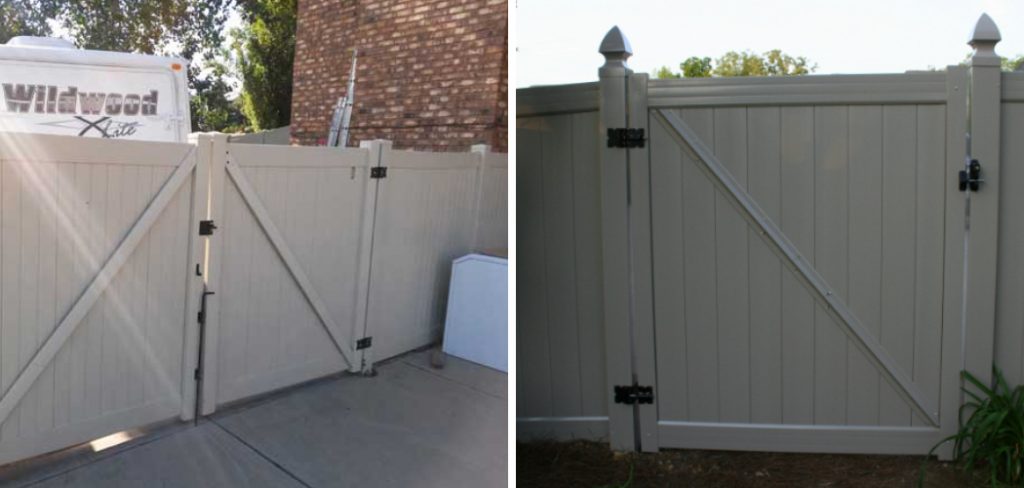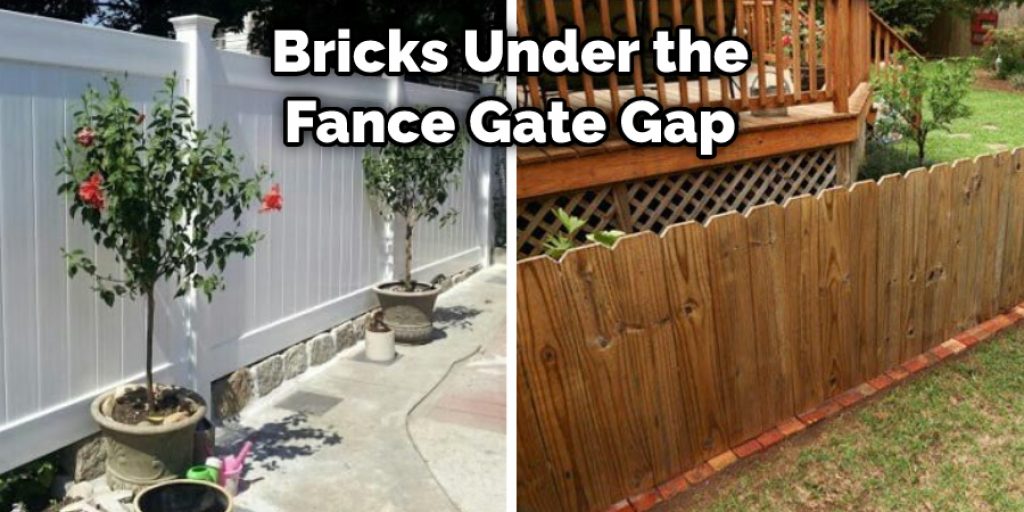Do you have a vinyl fence gate that is starting to sag? Then, it’s not too late to save it! This post will show you how to fix a sagging vinyl fence gate. Follow these simple steps, and your gate will be good as new in no time.

Summary: If you have a sagging vinyl fence gate, there are a few things that you can do to fix it. You may need to replace the gate entirely, or you may be able to fix it by replacing the hinge and spring.
What Is a Sagging Vinyl Fence Gate?
Vinyl fence gates are a great option for those looking for a durable and low-maintenance gate. Made out of vinyl – a synthetic resin made of chlorine and ethylene – these gates are available in a variety of colors and styles, making them a popular choice for many homeowners.
A vinyl fence gate is a type of door that can be opened by either swinging on hinges or sliding on a track. If the vinyl fence gate sags, it is most likely because the hinges are not properly aligned.
Another reason can be that the posts that the fence is attached to are not level. This can cause the vinyl fence gate to lean to one side. This can be fixed by leveling the posts that the gate is attached to.
Why It’s Important to Fix a Sagging Vinyl Fence Gate?
Your vinyl fence may be starting to sag and show its age, but with a little TLC it can look good as new. After all, vinyl fences are known for their durability and low maintenance requirements.
While a sagging gate may not seem like a big deal, it can cause several problems. First, it is difficult to open and close the gate, which can be frustrating.
Additionally, a sagging gate can also strain the hinges, causing them to break eventually. In extreme cases, a sagging gate can even cause the posts to lean, causing the entire fence to become unstable. So, as you can see, it’s important to fix a sagging vinyl fence gate as soon as you notice the problem.
How to Fix a Sagging Vinyl Fence Gate Step by Step Guide
Step 1: Inspect the Vinyl Fence Gate and Identify the Issue
Begin by examining the sagging vinyl fence gate to determine the cause of the issue. Look for signs of wear, damage, or loose components, such as hinges, latches, or screws. Identifying the root of the problem will help you determine the most effective solution.
Step 2: Gather Necessary Tools and Materials
To fix a sagging vinyl fence gate, you will need various tools and materials, depending on the specific repair required. Common items include:
- Screwdriver or drill
- Adjustable wrench or pliers
- Level
- Replacement hinges, latches, or screws (if necessary)
- Anti-sag gate kit (if required)
- Carpenter’s square
- Tape measure
- Wood or vinyl support blocks (if needed)
- Shims (if necessary)
Step 3: Tighten Loose Components
Loose hinges, latches, or screws can cause a vinyl fence gate to sag. Use a screwdriver or drill to tighten any loose components, ensuring that the gate is securely attached to the fence post. If the screws are stripped or damaged, replace them with new, appropriately sized screws.
Step 4: Adjust or Replace Hinges and Latches
Worn or damaged hinges and latches can contribute to a sagging gate. If your hinges or latches are bent, rusted, or otherwise compromised, consider replacing them with new, heavy-duty components. Adjust the position of the hinges and latches as needed to ensure proper alignment and function.
Step 5: Install an Anti-Sag Gate Kit
An anti-sag gate kit is designed to provide additional support to a sagging vinyl fence gate. These kits typically include a cable, turnbuckle, and brackets that can be installed diagonally across the gate to create tension and lift the sagging corner. Follow the manufacturer’s instructions to install the anti-sag gate kit on your vinyl fence gate.
Step 6: Check the Gate for Squareness
Using a carpenter’s square, check the corners of the gate to ensure that they are square. If the gate is out of square, it may be necessary to adjust the position of the hinges or latches, or to install additional support, such as wood or vinyl support blocks.
Step 7: Add Support Blocks or Shims
If your sagging vinyl fence gate requires additional support, consider installing wood or vinyl support blocks beneath the gate. These blocks can be attached to the fence post or gate frame to provide a solid base for the gate to rest on when closed. Alternatively, you can use shims to lift the sagging corner of the gate until it is level.
Step 8: Adjust the Gate’s Position on the Fence Post
In some cases, the sagging gate may be caused by the gate being improperly positioned on the fence post. If necessary, adjust the position of the gate on the post to ensure that it hangs level and operates smoothly.
Step 9: Ensure the Gate Operates Smoothly
Once you have completed the necessary repairs, test the gate to ensure that it opens and closes smoothly, and that the latch functions properly. Make any additional adjustments as needed to achieve optimal gate performance.
Step 10: Maintain Your Vinyl Fence Gate
Regular maintenance is essential to prevent future sagging or other issues with your vinyl fence gate. Periodically inspect the gate for signs of wear, damage, or loose components, and address any issues promptly. Keep the gate clean by washing it with a mild soap and water solution, and lubricate hinges and latches as needed to ensure smooth operation.
By following these steps, you can effectively fix a sagging vinyl fence gate and restore its proper function and appearance. Regular maintenance, proper installation, and timely repairs will help ensure the longevity of your vinyl fence gate, keeping it in excellent condition for years to come.
Step 11: Reinforce Fence Posts
In some cases, a sagging vinyl fence gate may be due to weakened or damaged fence posts. If you suspect this may be the issue, consider reinforcing the fence posts by adding support brackets, installing a concrete footing, or replacing damaged posts altogether.
Step 12: Check for Soil Erosion or Settling
Soil erosion or settling around the fence posts can cause the gate to sag. Inspect the area around the fence posts to identify any signs of erosion or settling. If necessary, add soil or gravel to the area, ensuring that it is properly compacted to provide a stable base for the fence posts and gate.
Step 13: Install a Gate Wheel
A gate wheel can provide additional support to a sagging vinyl fence gate, helping to distribute its weight more evenly and reduce stress on the hinges and fence posts. Choose a gate wheel that is compatible with your gate’s dimensions and material, and install it according to the manufacturer’s instructions.
Step 14: Ensure Proper Gate Alignment
A sagging vinyl fence gate may not align properly with the latch or fence posts. Check the alignment of the gate, and make any necessary adjustments to the hinges, latch, or fence post positioning to ensure that the gate aligns correctly and operates smoothly.
Step 15: Inspect and Replace Damaged Gate Components
Over time, the gate’s components may become worn or damaged, leading to sagging. Regularly inspect the gate’s frame, hinges, latch, and support structures for signs of wear or damage, and replace any compromised components as needed.
Step 16: Consult a Professional if Necessary
If you have tried the steps above and are still experiencing issues with your sagging vinyl fence gate, it may be time to consult a professional fencing contractor. They can assess your gate, identify the underlying issue, and recommend the most effective course of action to restore your gate to its proper function and appearance.
By following these steps and being proactive about gate maintenance, you can successfully fix a sagging vinyl fence gate and keep it in optimal condition for years to come. Addressing issues promptly, using high-quality components, and consulting a professional when necessary will help ensure the durability and functionality of your vinyl fence gate.
Frequently Asked Question
Why Do Gates Sag?
There are a few reasons why gates sag. One reason is that the posts may be too short, which can cause the gate to swing freely and sag. Another reason may be that the hinges are not properly secured or tightened. Finally, the gate may not be weighted down sufficiently, causing it to sag over time.
What Do You Put Under Gate Gap?
There are a few different ways to fix a saggy vinyl fence gate. One way is to put concrete blocks or bricks under the gate gap. Another way is to use screw-in tension braces. You can find these at home improvement stores.

Conclusion
If your vinyl fence gate is sagging, don’t fret! There are a few ways to fix it. You can use wood screws or nails to reinforce the joints or add a piece of wood across the top of the gate. You can also try using a cable system to keep the gate open and avoid saggy gates in the future. Thanks for reading our post about how to fix a sagging vinyl fence gate.
You May Also Read: How to Fix a Sagging Metal Bed Frame
